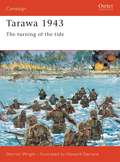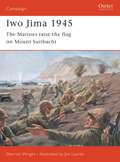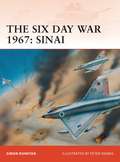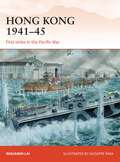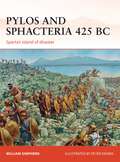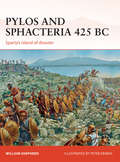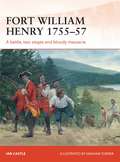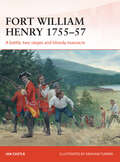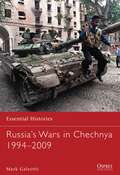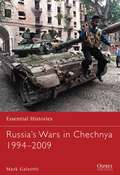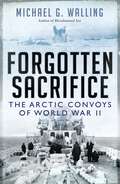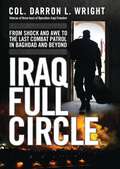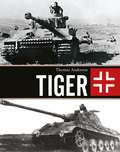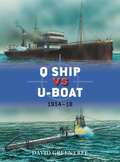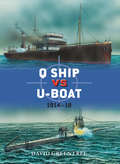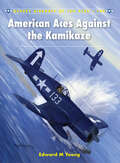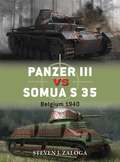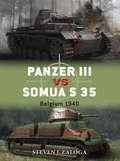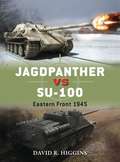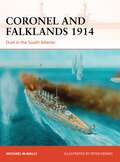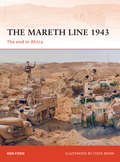- Table View
- List View
Tarawa 1943: The turning of the tide (Campaign)
by Howard Gerrard Derrick WrightThe island of Betio in the Tarawa Atoll was defended by the elite troops of the Special Naval Landing Force, whose commander, Admiral Shibasaki, boasted that "the Americans could not take Tarawa with a million men in a hundred years". In a pioneering amphibious invasion, the Marines of the 2nd Division set out to prove him wrong, overcoming serious planning errors to fight a 76-hour battle of unprecedented savagery. The cost would be more than 3000 Marine casualties at the hands of a garrison of some 3700. The lessons learned would dispel forever any illusions that Americans had about the fighting quality of the Japanese.
Iwo Jima 1945: The Marines raise the flag on Mount Suribachi (Campaign)
by Jim Laurier Derrick WrightOne of the decisive battles of the Second World War in the Pacific, Iwo Jima was described by Lieutenant-General Holland Smith, Commander Fleet Marine Forces Pacific, as "The most savage and most costly battle in the history of the Marine Corps " a titanic struggle that eclipsed all that had gone before. Situated halfway along the B-29 Superfortress route to the Japanese mainland, the island was of major strategic importance to the US Air Force, but also to the Japanese, 20,000 of whom were deeply entrenched in the island. This book provides a definitive account of the battle, from its origins to its hard-fought conclusion.
The Six Day War 1967: Sinai (Campaign)
by Peter Dennis Simon DunstanIn May 1967, Egypt expelled the United Nations peacekeeping forces stationed in the Sinai desert and deployed its army along its border with Israel, its moves coordinated with those of Jordan and Syria. By June, Israel realized that the international community would not act, and so it launched a pre-emptive strike against the combined Arab forces. The ensuing Six Day War was a crushing defeat for the Arab world, one that tripled the area controlled by Israel and which sowed the seeds for the Yom Kippur War of 1973 and the continuing strife in the region. Written by the author of Osprey's Yom Kippur War, this volume covers the background to the war and the campaign against the Egyptians in the Sinai Peninsula, including the initial devastating air assault that showed the world how vital air supremacy was in modern combat.
Hong Kong 1941–45: First strike in the Pacific War (Campaign #263)
by Giuseppe Rava Benjamin LaiOn 8th December 1941, as part of the simultaneous combined attack against Pearl Harbor, the Imperial Japanese Army (IJA) invaded the Philippines, Thailand and Malaysia and the British colony of Hong Kong. After only 18 days of battle the defenders, a weak, undermanned brigade, were overwhelmed by a superior force of two battle-hardened IJA divisions. What defines the battle of Hong Kong was not the scale just 14,000 defended the colony but the intensity of this battle, fought not only by the British Army, Navy and Air Force but also Canadians, Hong Kong's own defence force, the Indian Army and many civilians. The campaign itself is characterized by a fierce land battle, with long artillery duals and as well as fast naval actions with intense actions at the Gin Drinkers Line as well as the battle of Wong Nai Chung Gap where a handful of defenders took on an entire Japanese regiment. Less known but equally important are individual acts valour such as CSM John Robert Osborne winning a posthumous VC, throwing himself over a Japanese grenade to save fellow combatants.
Hong Kong 1941–45: First strike in the Pacific War (Campaign #263)
by Giuseppe Rava Benjamin LaiOn 8th December 1941, as part of the simultaneous combined attack against Pearl Harbor, the Imperial Japanese Army (IJA) invaded the Philippines, Thailand and Malaysia and the British colony of Hong Kong. After only 18 days of battle the defenders, a weak, undermanned brigade, were overwhelmed by a superior force of two battle-hardened IJA divisions. What defines the battle of Hong Kong was not the scale just 14,000 defended the colony but the intensity of this battle, fought not only by the British Army, Navy and Air Force but also Canadians, Hong Kong's own defence force, the Indian Army and many civilians. The campaign itself is characterized by a fierce land battle, with long artillery duals and as well as fast naval actions with intense actions at the Gin Drinkers Line as well as the battle of Wong Nai Chung Gap where a handful of defenders took on an entire Japanese regiment. Less known but equally important are individual acts valour such as CSM John Robert Osborne winning a posthumous VC, throwing himself over a Japanese grenade to save fellow combatants.
Pylos and Sphacteria 425 BC: Sparta's island of disaster (Campaign)
by Peter Dennis William ShepherdDuring the Peloponnesian War the Athenians occupied the promontory of Pylos to counter Sparta's repeated invasions of Attica. Over two days of fighting the small garrison beat off the Spartan army and the returning Athenian fleet won a crushing victory in the nearby waters, stranding a contingent of elite Spartan hoplites on the island of Sphacteria. With the campaigning season drawing to a close the Athenians mounted an attack on the island using an unconventional amphibious night assault they overran the Spartan outpost covering the beaches and light-armed missile troops landed at daybreak in overwhelming numbers. The Spartans were slowly driven back to their stronghold, losing men steadily as they were prevented from engaging in the hand-to-hand fighting at which they excelled. With their commander dead and his deputy incapacitated by wounds, the 292 survivors surrendered. This was a surprising blow to the Spartans' glorious reputation, and these prestigious prisoners-of-war served the Athenians very well as bargaining counters in the diplomatic activity that punctuated the hostilities that continued for the next four years.
Pylos and Sphacteria 425 BC: Sparta's island of disaster (Campaign #261)
by Peter Dennis William ShepherdDuring the Peloponnesian War the Athenians occupied the promontory of Pylos to counter Sparta's repeated invasions of Attica. Over two days of fighting the small garrison beat off the Spartan army and the returning Athenian fleet won a crushing victory in the nearby waters, stranding a contingent of elite Spartan hoplites on the island of Sphacteria. With the campaigning season drawing to a close the Athenians mounted an attack on the island using an unconventional amphibious night assault they overran the Spartan outpost covering the beaches and light-armed missile troops landed at daybreak in overwhelming numbers. The Spartans were slowly driven back to their stronghold, losing men steadily as they were prevented from engaging in the hand-to-hand fighting at which they excelled. With their commander dead and his deputy incapacitated by wounds, the 292 survivors surrendered. This was a surprising blow to the Spartans' glorious reputation, and these prestigious prisoners-of-war served the Athenians very well as bargaining counters in the diplomatic activity that punctuated the hostilities that continued for the next four years.
Fort William Henry 1755–57: A battle, two sieges and bloody massacre (Campaign #260)
by Graham Turner Ian CastleAfter the British garrison of Fort William Henry in the colony of New York surrendered to the besieging army of the French commander Marquis de Montcalm in August 1757, it appeared that this particular episode of the French and Indian War was over. What happened next became the most infamous incident of the war – and one which forms an integral part of James Fenimore Cooper's classic novel The Last of the Mohicans – the 'massacre' of Fort William Henry. As the garrison prepared to march for Fort Edward a flood of enraged Native Americans swept over the column, unleashing an unstoppable tide of slaughter. Cooper's version has coloured our view of the incident, so what really happened? Ian Castle details new research on the campaign, including some fascinating archaeological work that has taken place over the last 20 years, updating the view put forward by The Last of the Mohicans.
Fort William Henry 1755–57: A battle, two sieges and bloody massacre (Campaign #260)
by Ian CastleAfter the British garrison of Fort William Henry in the colony of New York surrendered to the besieging army of the French commander Marquis de Montcalm in August 1757, it appeared that this particular episode of the French and Indian War was over. What happened next became the most infamous incident of the war – and one which forms an integral part of James Fenimore Cooper's classic novel The Last of the Mohicans – the 'massacre' of Fort William Henry. As the garrison prepared to march for Fort Edward a flood of enraged Native Americans swept over the column, unleashing an unstoppable tide of slaughter. Cooper's version has coloured our view of the incident, so what really happened? Ian Castle details new research on the campaign, including some fascinating archaeological work that has taken place over the last 20 years, updating the view put forward by The Last of the Mohicans.
Russia’s Wars in Chechnya 1994–2009 (Essential Histories)
by Mark GaleottiIn this fully illustrated book an expert on the conflicts traces the progress of the wars in Chechnya, from the initial Russian advance through to urban battles such as Grozny, and the prolonged guerrilla warfare in the mountainous regions. He assesses how the wars have torn apart the fabric of Chechen society and their impact on Russia itself. Featuring specially drawn full-colour mapping and drawing upon a wide range of sources, this succinct account explains the origins, history and consequences of Russia's wars in Chechnya, shedding new light on the history – and prospects – of the troubled region.
Russia’s Wars in Chechnya 1994–2009 (Essential Histories #78)
by Mark GaleottiIn this fully illustrated book an expert on the conflicts traces the progress of the wars in Chechnya, from the initial Russian advance through to urban battles such as Grozny, and the prolonged guerrilla warfare in the mountainous regions. He assesses how the wars have torn apart the fabric of Chechen society and their impact on Russia itself. Featuring specially drawn full-colour mapping and drawing upon a wide range of sources, this succinct account explains the origins, history and consequences of Russia's wars in Chechnya, shedding new light on the history – and prospects – of the troubled region.
Forgotten Sacrifice: The Arctic Convoys of World War II
by Michael G. WallingThe story begins in October 1939, when Germany and the Soviet Union began diplomatic maneuvering. The action accelerates with Winston Churchill's decision in 1941 to provide supplies to Soviet forces battling the German invasion and for five long years, thousands of men and women fought ferociously in the coldest corner of hell on earth. Some fought for survival, some struggled to help others survive, and some sought to crush their enemies. The Arctic Convoys were war without mercy. If man-made death didn't get you, the Arctic's weapons of ice and cold would. These natural weapons killed regardless of whose side you were on or how just your cause. No one escaped unscathed. Author Mike Walling captures the convoy's bitter essence and reveals a timeless tale of determination, heroism, sacrifice, and the strength of the human spirit.
Iraq Full Circle: From Shock and Awe to the Last Combat Patrol in Baghdad and Beyond
by Darron L. WrightFrom 2003 through 2010, more than 200,000 men and women were deployed in Iraq. For seven years, they fought ferociously in the blistering sands in the Land Between the Two Rivers. Some fought for pride or survival, some to bring democracy to a forsaken land that has known only tyranny and strife. Scores of books have been published about the war, most criticizing the strategies and execution. Some have been personal memoirs capturing the heroism and sacrifice. Here U.S. Army LTC Darron Wright, a proven combat leader, joins forces with author Mike Walling to lift the veil on the Iraq War, revealing the build-up of troops; the equipping, training, and planning; the capture of Saddam Hussein; the formation of the new Government; and the last patrol. Through vivid stories and military documents, this provides readers with a first-hand of the full conflict.
Tiger
by Thomas AndersonOne of the most feared weapons of World War II, the Tiger tank was a beast of a machine which dominated the battlefields of Europe with its astonishing size, speed and firepower, which continues to fascinate more than 70 years after it was first designed. Revealing its design and development history, Thomas Anderson draws upon original German archival material to tell the story of the birth of the Tiger. He then analyzes its success on the battlefield and the many modifications and variants that also came into play. Illustrated throughout with rare photographs and drawings, this is a unique history of what is easily the most famous tank ever produced.
Q Ship vs U-Boat: 1914–18 (Duel)
by Peter Dennis Ian Palmer David GreentreeQ ships came in all shapes and sizes – coastal steamer, trawler, barque, yacht or schooner – but all had to look harmless in order to lure their opponents to the surface and encourage them to attack. Armaments differed according to ship size; steamers commonly had 4in guns mounted amidships and in the bow, trawlers 3-pdrs and sailing ships 12-pdrs. Those who served on Q ships had to accept that their U-boat opponents would be able to strike first. Q ship captains kept ready a 'panic crew', which was trained to act out an elaborate evacuation to convince the U-boat commander that the ship was being abandoned by its crew. The Q ship captain would remain behind with a handful of other crewmen manning the guns, which remained hidden until the most opportune time to unmask and engage the U-boat. The Q ship concept had emerged early in the war when no other method seemed likely to counter the U-boat threat, and flourished until new technologies and tactics were developed, tested and implemented.
Q Ship vs U-Boat: 1914–18 (Duel #57)
by Peter Dennis Ian Palmer David GreentreeQ ships came in all shapes and sizes – coastal steamer, trawler, barque, yacht or schooner – but all had to look harmless in order to lure their opponents to the surface and encourage them to attack. Armaments differed according to ship size; steamers commonly had 4in guns mounted amidships and in the bow, trawlers 3-pdrs and sailing ships 12-pdrs. Those who served on Q ships had to accept that their U-boat opponents would be able to strike first. Q ship captains kept ready a 'panic crew', which was trained to act out an elaborate evacuation to convince the U-boat commander that the ship was being abandoned by its crew. The Q ship captain would remain behind with a handful of other crewmen manning the guns, which remained hidden until the most opportune time to unmask and engage the U-boat. The Q ship concept had emerged early in the war when no other method seemed likely to counter the U-boat threat, and flourished until new technologies and tactics were developed, tested and implemented.
American Aces against the Kamikaze (Aircraft of the Aces #109)
by Edward M. YoungThe Japanese High Command realised that the loss of Okinawa would give the Americans a base for the invasion of Japan. Its desperate response was to unleash the full force of the Special Attack Units, known in the west as the Kamikaze ('Divine Wind'). In a series of mass attacks in between April and June 1945, more than 900 Kamikaze aeroplanes were shot down. Conventional fighters and bombers accompanied the Special Attack Units as escorts, and to add their own weight to the attacks on the US fleet. In the air battles leading up to the invasion of Okinawa, as well as those that raged over the island in the three months that followed, the Japanese lost more than 7,000 aircraft both in the air and on the ground. In the course of the fighting, 67 Navy, 21 Marine, and three USAAF pilots became aces. In many ways it was an uneven combat and on numerous occasions following these uneven contests, American fighter pilots would return from combat having shot down up to six Japanese aeroplanes during a single mission.
Forgotten Sacrifice: The Arctic Convoys of World War II
by Michael G. WallingThe story begins in October 1939, when Germany and the Soviet Union began diplomatic maneuvering. The action accelerates with Winston Churchill's decision in 1941 to provide supplies to Soviet forces battling the German invasion and for five long years, thousands of men and women fought ferociously in the coldest corner of hell on earth. Some fought for survival, some struggled to help others survive, and some sought to crush their enemies. The Arctic Convoys were war without mercy. If man-made death didn't get you, the Arctic's weapons of ice and cold would. These natural weapons killed regardless of whose side you were on or how just your cause. No one escaped unscathed. Author Mike Walling captures the convoy's bitter essence and reveals a timeless tale of determination, heroism, sacrifice, and the strength of the human spirit.
Iraq Full Circle: From Shock and Awe to the Last Combat Patrol in Baghdad and Beyond
by Darron L. WrightFrom 2003 through 2010, more than 200,000 men and women were deployed in Iraq. For seven years, they fought ferociously in the blistering sands in the Land Between the Two Rivers. Some fought for pride or survival, some to bring democracy to a forsaken land that has known only tyranny and strife. Scores of books have been published about the war, most criticizing the strategies and execution. Some have been personal memoirs capturing the heroism and sacrifice. Here U.S. Army LTC Darron Wright, a proven combat leader, joins forces with author Mike Walling to lift the veil on the Iraq War, revealing the build-up of troops; the equipping, training, and planning; the capture of Saddam Hussein; the formation of the new Government; and the last patrol. Through vivid stories and military documents, this provides readers with a first-hand of the full conflict.
Tiger (General Military Ser.)
by Thomas AndersonOne of the most feared weapons of World War II, the Tiger tank was a beast of a machine which dominated the battlefields of Europe with its astonishing size, speed and firepower, which continues to fascinate more than 70 years after it was first designed. Revealing its design and development history, Thomas Anderson draws upon original German archival material to tell the story of the birth of the Tiger. He then analyzes its success on the battlefield and the many modifications and variants that also came into play. Illustrated throughout with rare photographs and drawings, this is a unique history of what is easily the most famous tank ever produced.
Panzer III vs Somua S 35: Belgium 1940 (Duel)
by Steven J. Zaloga Richard ChasemoreThe armour clashes in May 1940 were the biggest the world had yet seen, as the sweeping German advances of that period came to epitomize Blitzkrieg. The Wehrmacht's Panzer III was well matched by the French Somua S35 tanks, the two representing very different design philosophies and yet both ranking among the best in the world at the time. Fully illustrated with specially commissioned colour artwork, this work draws upon the latest research to provide a definitive analysis of the clash between these two high-quality, cutting-edge tank designs. It describes one of the key duels at the heart of a new type of warfare, in the epic battles at the outset of Hitler's conquest of France and the Low Countries.
Panzer III vs Somua S 35: Belgium 1940 (Duel #63)
by Steven J. Zaloga Richard ChasemoreThe armour clashes in May 1940 were the biggest the world had yet seen, as the sweeping German advances of that period came to epitomize Blitzkrieg. The Wehrmacht's Panzer III was well matched by the French Somua S35 tanks, the two representing very different design philosophies and yet both ranking among the best in the world at the time. Fully illustrated with specially commissioned colour artwork, this work draws upon the latest research to provide a definitive analysis of the clash between these two high-quality, cutting-edge tank designs. It describes one of the key duels at the heart of a new type of warfare, in the epic battles at the outset of Hitler's conquest of France and the Low Countries.
Jagdpanther vs SU-100: Eastern Front 1945 (Duel)
by Richard Chasemore David R. HigginsAs World War II in Europe reached its end, armour development and doctrine had experienced several years of massively accelerated change, especially within the crucible of the Eastern Front. The German Jagdpanther and Soviet SU-100, both turretless tank-destroyer designs based on a 'traditional' turret-tank chassis, were the culminating examples of how the progression of experience, resources and time constraints produced vehicles that were well suited for roles of defence and offence, respectively. The Jagdpanther represented a well-balanced solution and an excellent use of limited resources, while the SU-100 was a natural progression of the SU-85, where numbers produced compensated for rudimentary construction, poor crew comfort and limited optics.
Coronel and Falklands 1914: Duel in the South Atlantic (Campaign #248)
by Peter Dennis Michael McNallyUpon the outbreak of war, the British Royal Navy was deployed globally, whilst the Imperial German Navy was concentrated in two areas – Home Waters and Tsingtao, the home port of the crack East Asia Cruiser Squadron which, under the command of Admiral von Spee contained some of Germany's most modern cruisers. As Spee made his way to the Chilean port of Valparaiso, he met the British 4th Cruiser Squadron which had been ordered to engage and defeat the German force. This resulted in the battle of Coronel where the antiquated British warships proved no match for Spee's modern cruisers. It was the first naval defeat suffered by the Royal Navy in over 100 years. When news reached London, panic reigned and two ships HMS Inflexible and Invincible were sent to lead the force against Spee. When bad weather delayed the German arrival, Spee knew that he had to stand and fight, unaware that amongst the ships opposing him were two modern battlecruisers which outclassed any of his own squadron's ships. Given the presence of Inflexible and Invincible, the result of the battle had an inevitable outcome and after several hours hard combat, Spee's ships were defeated.
The Mareth Line 1943: The end in Africa (Campaign #250)
by Steve Noon Ken FordThe battle of El Alamein saw the shattering of Germany's hopes for victory in North Africa and from this point on the end was inevitable. In the six months that passed before the final surrender there was much hard fighting, as the defeated German and Italian armies sought to hold off the encroaching Eighth Army. Rommel, his health suffering, fought a number of major actions during this campaign before his forces settled into the pre-war French defensive position the Mareth Line. All the way he was pursued by an increasingly confident Eighth Army under the command of General Montgomery, although he was unable to outflank the retreating German and Italian forces decisively, and Rommel was even able to divert forces to inflict a sharp defeat on the newly arrived US forces at Kasserine Pass in February 1943. This was one of Rommel's last acts in the Desert War as his health problems forced his return to Germany shortly afterwards. The stage was now set for the last great battle of the Desert War as the veteran formations of the British Eighth Army took on their foes in the Afrikakorps for one last time in the major set-piece battle for the Mareth Line.
